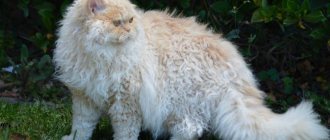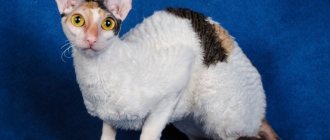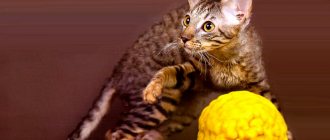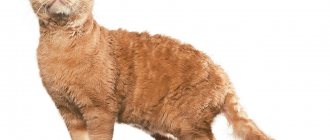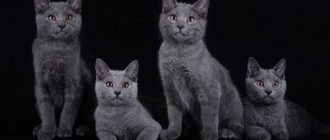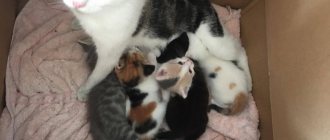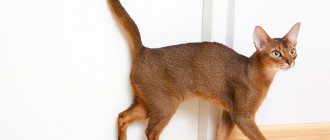What does a Devon Rex look like?
“Elves” have an unusual, attractive and memorable appearance. No matter who looks at them, the image of a Devon Rex will stay in a person’s head for a long time. It should also be noted that their appearance is quite paradoxical. Despite their tiny size, Devon Rex dogs have good strength and a powerful body. From the photo of the Devon Rex it is immediately clear that the breed belongs to the category of exotic.
Muzzle
According to standards, the head of a Devon Rex should resemble the shape of a maple leaf (many people compare it to a heart), be slightly elongated in width, and also have a small shape.
Ears are one of the main distinguishing features of this breed. They are very large, deep-set and elongated. They are often compared to butterflies. There may be tassels at the ends. They are also quite abundantly covered with hair, especially at the base.
Large, round eyes are set wide and slightly oblique. It is thanks to them that Devon Rexes have a little mystery. The color matches the coat color. For example: the Siamese has blue eyes. Eye color is distinguished by its saturation and brightness.
Body type
The “chest” of the Devon Rex is very powerful, which sounds paradoxical if you look at their thin, slender and graceful body. The body of male cats may be larger than that of females. The breed has wide bones and a rounded profile. The body itself is medium in size, even small.
The legs are thin and long, but quite powerful. The limbs are round and small.
The tail is long, elegant and thin, the hair on it is distributed everywhere, but not as densely as on other areas.
Coat and color
The Devon Rex's coat is soft. It appears this way due to the length and thickness of the hair. Thanks to this, it has a slight curl, which is very noticeable when you pet the animal. In general, the hair is distributed throughout the body, but there is slightly less hair on the belly, chest and head. She does not need special care.
The colors of the Devon Rex are not so diverse, but there are still several of them. Here are the most common ones:
- Siamese;
- tabby color;
- cinnamon;
- tortoiseshell.
There are no varieties of Devon Rex; the breed follows a single standard. The only difference is the color of the curly fur.
Appearance of Devon Rex cats
Devon Rex cats grow to medium sizes. The animals' bodies are strong and muscular, but this does not prevent them from looking very elegant. The main difference between the breed is its short and curly coat. The curls are best seen on the back. The coat can be of any color.
The small muzzle has pronounced cheekbones. Devons have huge eyes and ears. The whiskers of cats of this breed are also not the same as those of other cats. They are short and slightly curled.
CFA Standards
According to the current breed standard, the animal must meet the following characteristics:
- The head is small in size, the muzzle is slightly blunted at the end, the cheekbones are pronounced, the line of the forehead smoothly transitions to a flat skull.
- A well-developed chin that connects in one vertical line to the nose.
- The eyes are large, have a clear oval shape, and are set wide apart.
- The ears are large, their outer edges may extend beyond the outline of the head. The ends of the ears are slightly rounded. The outer side of the ear is covered with a thin layer of fur; there may be small tufts at the tips of the ears, but not always.
- The body is strong and flexible.
- The limbs are slender, and the paws themselves are small and round in shape.
- The tail is thin with a pointed tip, covered with short wavy fur.
Representatives of this breed may have various deficiencies, the presence of which is grounds for disqualification. Thus, an animal will not be able to take part in an exhibition if it is found to have:
- large bald areas on the body,
- too long hair
- elongated head shape,
- tail kinks,
- wrong number of fingers,
- bare or bushy tail,
- strabismus,
- weak hind limbs.
Body structure and size
Representatives of the Devon Rex breed boast a strong physique. The weight of adult cats can reach 4.5 kg. Kitties, as a rule, are more miniature, their weight does not exceed 3.5 kg. The body length of Devons is about 60 cm. The animal’s limbs are thin and long, and it moves very easily. Cats reach a height of 25–35 cm.
The large ears are set very low. This arrangement gives the animals an unusual appearance. Their long (25–35 cm) and thin tail adds grace to cats.
Features of wool
According to the standard, the body of cats should be completely covered with curly fur. It may be less dense in the area of the cheeks, chest and abdomen. When stroking the animal, you feel the soft texture of the fur and its wavy structure.
Although the Devon Rex breed is not very common in Russia, I was lucky enough to see this amazing cat and even play with her a little. My colleague has such a curly-haired elf living at home. The cat really looks unusual. What surprised me most was her fur. Waves of wool can be easily felt if you run your hand over the animal’s body. Outwardly, the wool seems somehow tough, but in fact it is very soft and pleasant to the touch. Not only do they have curled fur, but they also have antennae, which also looks quite unusual.
Due to the nature of their coat, Devons practically do not shed, so many people mistakenly consider these cats to be hypoallergenic. Short and curly hair does not mean that the animal will not cause an allergic reaction in humans.
The length of a cat's fur has absolutely nothing to do with allergies that a person may experience when in contact with an animal. The allergen is the glycoprotein FelD1, which is present in the body of any cat.
Devon Rex color
The breed appeared relatively recently, so different coat colors are allowed. The CFA Association groups them as follows:
- single-color: red, blue, chocolate, white, cream, black and others,
- bicolors - the main color of the coat is combined with white,
- tabby - striped color of cats, including silver and tortoiseshell,
- other options: color points (there is a contrast of colors on the body), minky, tortoiseshell and others.
Photo gallery: curly Devons fascinate with their looks
Devons are friendly not only to humans, but also to other animals
Devon Rexes are very active, they are able to climb into the most secluded corner of the house
Devons really miss their owner when they are alone at home
Devon Rexes love to sleep in the same bed with their owner.
Devons remain active throughout their lives
Devon Rex character
The first thing to note about the Devon Rex is its playfulness. Cats of this breed are characterized by mobility, curiosity, and activity throughout their lives. Some may consider this a minus, while others may consider this a plus. In any case, this is very important to consider when purchasing a pet.
This character trait can play a cruel joke on the owner. Due to their curiosity in childhood and adulthood, Devon Rex dogs may show increased attention to wires, furniture, and wallpaper. Teaching your kitten to use a scratching post from childhood will save you from chewed objects. Therefore, it is recommended to pay as much attention as possible to your pet during the first year of life. This way you can achieve good behavior and even teach the cat some commands.
To all this should be added their love for heights, so you should take care in advance of a secluded place for your future pet at a height. From there the pet will be able to watch everything that happens in the house.
“Elves” are very attached to their owner, so before buying you should think about whether you can pay enough attention to the pet or not. This is very important: if you are away from home all the time, this can lead to bad consequences. The animal will begin to behave mischievously and aggressively, and individuals with a softer character may become ill.
It follows from this that the Devon Rex will always be near the owner. The cat will sleep with you, sit, and do chores around the house.
It's worth talking about very much. They can meow, purr and make unusual sounds very often.
Devon Rexes treat other pets very well, but you should not have two animals of this breed. They may not share the owner, which will lead to constant hostility.
“Elves” do not show aggression towards children, nor do they show great interest. They love to communicate with adults and their owner. If you teach your child the rules of handling animals, then nothing bad will happen. The Devon Rex will not mind playing any game with a small family member.
The breed also does not show much interest in strangers. Devons will not hide or act aggressively; rather, they will carefully study a new person.
Raising a Devon Rex
Devon Rexes have good intelligence, good character and show interest in everything new. All of the above is the key to good training and education of the Devon Rex.
Any pet should be taught certain rules from birth so that no one or nothing gets hurt later. Such rules include toilet training and scratching posts.
If you have the desire, you can easily teach your pet some simple commands using affection and treats.
Devon Rex Health
Possible diseases
At birth, kittens may be intolerant to their mother's milk, so breeders need to monitor the condition of their babies very closely to immediately prevent deterioration in their health.
Devons also experience muscle weakness during childhood. If there are signs of myopathy (this is the name of this disease), then, unfortunately, this will remain until the end of life. Now, fortunately, such cases are very rare.
List of diseases that can occur in adult animals:
- hypertrophic cardiomyopathy;
- dermatitis;
- joint problems.
It is recommended to visit your veterinarian regularly to identify any emerging disease in the early stages and not risk the health of your Devon Rex.
Reproductive health
The onset of estrus in a Devon female can occur quite early - at 6 months. Further, estrus will be repeated several times a year. If estrus occurs more than 3-4 times a year and there are no plans to breed a girl, it is better to sterilize so as not to exhaust the animal’s body.
Mating is possible in the second or third heat, but the choice of a partner should be approached responsibly. The fact is that cats of this breed have two types of blood: A and B. If you cross two different types, then the kittens may experience a Rh conflict during the feeding period, and they will die. Therefore, before mating, you need to visit the veterinarian in advance and donate blood to determine its type.
Rh conflict is possible even if the mother and father of the offspring have the same blood type - one of them may display a recessive gene that is inherited by one kitten or the entire litter. In this case, the kittens are given to a cat with a suitable blood type or artificially fed during the first days of life.
History of the origin of the Devon Rex cat
The history of the Devon cat originates in the county of Devonshire in the UK. A woman who feeds strays, Baryl Cox, picked up a pregnant cat. On July 15, 1960, an unusual black and brown kitten was born into the litter. He was very different from his brothers: the coat was curly, the head seemed to be flattened with large ears, and the front llamas were shorter than the back ones. The owner named him Kirly (from the English curly - curly, wavy).
In 1960, an exhibition was held in Cornwall of the Cornish Rex, which at that time was the only owner of curly hair. Beryl contacted breeder Brian Sterling Webb and sold her the kitten. Brian crossed two curly-haired cats and got a completely straight-haired litter. The breeder began to figure out why this was happening. It was found that cats have two different genes. This was the reason to divide cats into two breeds.
Subsequently, they decided to develop an individual program to preserve the gene and create a new Devonshire Rex breed. The first standard was developed in 1967. Kirley became the founder of the breed. At the age of 4 he stopped participating in breeding, but continued to attend shows. In 1970, there was a car accident, as a result of which the cat died.
Features of feeding and diet
Devon Rex should be fed only with professional food - you should not buy economy-class food, this will harm the pet. Also, you shouldn’t think about eating “from the table”, since choosing a good diet is quite difficult.
If you still decide to prepare food for your pet yourself, then the diet must include: meat, lean fish, cereals, vegetables, dairy products (with a reduced percentage of fat).
You should remove from the diet: chocolate, fruits, milk, liver, spicy and spicy foods, legumes, potatoes, baked goods.
It is better to give meat and minced meat not boiled, but scalded, in pieces of 100-150 grams. Occasionally it is worth pampering your pet with lightly salted cheese or eggs.
Before creating a diet, you should consult with a veterinarian and, based on your pet’s health, create an individual menu or choose the most suitable food.
Care and maintenance.
Caring for the coat of a Devon Rex is no different from caring for the coat of any other cat. Pets should be combed as needed - mainly during mild shedding.
For any animal in the house you need to have separate bowls. If you feed your cat store-bought food, then you should allocate three bowls: for dry food, for canned food and for water. The depth should be average, since the Devon Rex is small. Bowls should be washed as needed.
A scratching post is a necessary element in the life of any cat. Experienced owners advise purchasing vertical scratching posts “for growth” so as not to change them every few months.
It is not a fact that the pet will sleep in the place allocated to it. You can buy ready-made structures at a pet store, where the sleeping place and scratching post are located on several tiers. There the cat will periodically doze off, but at night it will most likely come to its owner to sleep, and it will be simply impossible to kick it out.
Ear and eye care is carried out infrequently, but regularly (about once a week). You can easily purchase special wipes at a pet store - they are ideal and will not cause inflammation. Do not use alcohol, oils or other products under any circumstances; all this will only harm your pet.
Devons also need to have their claws trimmed. To do this, buy special rounded scissors at a pet store; regular scissors will not work - they peel off the nail plates. You need to cut carefully, not going further than 5-6 millimeters from the tip of the claw. The space under the claws also needs to be cleaned - this is where the Devon Rex accumulates a large amount of dirt and grease. In fact, the process is quite simple; you just need to get used to it from childhood. “Manicure” and cleaning of the claw space should be done once every 10-15 days.
Dental care should not be overlooked - without it, the pet is at risk of developing plaque, caries, etc. Once a week, using a bandage wrapped around your finger or a pet brush with zoopaste, you need to carefully walk over the Devon Rex’s teeth. Instead, you can use special chewing treats designed for cleaning teeth.
If you buy a pet from a good breeder, then by the time of purchase the kitten will already be litter box trained. Of course, in a new home, it will be more difficult for the animal to adapt to a new place to go to the toilet. To do this, the breeder will definitely give you the filler that he used while the pet was with him, and this will make the habituation process easier.
In general, caring for and maintaining a Devon Rex is not considered difficult or troublesome. The main thing is to accustom the kitten to hygiene procedures from an early age.
History of the breed
The first mention of curly-haired kittens dates back to 1960, when there was a new addition to the family of Englishwoman Beryl Cox.
Her smooth-haired pet gave birth to a very unusual baby with curly hair. The kitten was named Curly, which translates as “curly.” Cox, who noted the small pet's resemblance to a Cornish Rex, rushed to contact Brian Stirling-Webb, a Cornish breeder. To everyone's surprise, the mating between Curly and Cornish Rex turned out to be a failure. The curls were not inherited by any of the kittens.
Further research revealed that the genes responsible for curly hair are recessive, but not identical:
- rex gene I – gene found in Cornish people;
- rex gene II is a gene found in the Devon Rex.
The desired offspring were obtained only through inbreeding, when Curly was the father and one of his kittens with normal coat was the mother. With this mating, 2 “rex gene II” genes were transmitted to the kittens, which eliminated the suppression of curls by the dominant gene.
In 1972, the breed received official recognition from the ACFA, and in 1979 from the CFA and TICA. Due to the meager gene pool, organizations allow matings with representatives of other breeds.
Tips for choosing a kitten.
Buying a kitten secondhand means putting yourself at risk, especially if the price is too low. A good cattery should have 7-8 years of experience and a large database of kittens sold. Particular attention should be paid to the price: the lower it is, the less conscientious the breeder was towards his pupils. Often these Devon Rex kittens have diseases that appear at a later age, as well as a poor pedigree.
Next, you need to decide on the class of pet you need. If you want a pet, then a pet class is suitable. If for exhibitions, you need the most expensive show class. And if you want to start breeding this breed, then the choice will fall on the breeding class.
If you have your sights set on a show-class kitten, then you should know a few points in which the animal will not be able to receive a high rating or will be disqualified. Animals with too coarse fur, disproportionate ears and head, or a short tail may receive a low score. Disqualification also awaits pets with a crooked tail, bald spots, strabismus, polydactyly and too long hair.
It is worth noting that when purchasing a pet, no one will guarantee a successful exhibition career. The main thing you need is to pay attention to the condition of the animal, and also ask to see its parents.
Be sure to pay attention to the conditions in which the animals are kept. The area must be clean and tidy. Observe the kitten itself - its behavior can say a lot. Since Devon Rexes are quite active animals, the future pet should not be lethargic and bored. It should not have a painful appearance or external defects.
Once you have decided on a kitten, ask to see the breeder's veterinary passport. The animal must have all vaccinations according to age; it is not necessary to have a brand. If the cattery takes care of its kittens, they will already be litter box and scratching post trained by the time you take them home. The age of purchase of a kitten must be at least 3 months.
How much does a Devon Rex cost?
The average price of a Devon Rex in the Russian Federation is from 25,000 to 35,000 rubles. Firstly, it all depends on the class of the animal being purchased. If you choose a breed class (for breeding), then the price will start from 30,000-35,000 rubles. The price for a show-class kitten starts at least 30 thousand rubles. If you just need a pet, then the price will be about 25,000 rubles, but if the kitten has minor external defects that do not affect its health, then the price will be slightly lower.
All kittens whose cost is significantly less than 20 thousand most likely have health problems or not a very good pedigree.
How to choose the right Devon Rex pet, prices, where to buy
Nurseries begin selling kittens when they reach 3 months of age. At this age, the animal has already been vaccinated. You should not buy a kitten from dubious advertisements. In this case, there is a very high risk of purchasing a non-purebred animal. It is better to give preference to nurseries with a proven reputation.
When choosing a Devon, you need to pay attention to the conditions in which the kittens and their mother live. In addition, attention should be paid to the following points:
- the animal must be moderately well-fed, without excessive thinness,
- the kitten should behave actively and playfully; at the age of 2 months, Devons already begin to show their character in full glory,
- the kitten's eyes and ears should be clean, and there should be no rashes on the skin,
- Curly fur should not have bald spots.
Many people think that Devon Rex can be easily confused with Cornish Rex, but this is not true; the animals have significant differences.
Table: differences between Devon Rex and Cornish Rex, how not to make a mistake when choosing a kitten
| Devon Rex | Cornish Rex |
|
|
In Russia you can buy Devon Rex kittens in the following nurseries:
- Piakriks, Moscow,
- Soul-Race, Moscow,
- CurlyClown, Moscow,
- Indigo Planet, Volgograd,
- Velvet Elves, Tolyatti.
- Lovely Sharmel, St. Petersburg.
The price of kittens of this breed, like any other, depends on the class of the animal and the pedigree lines. Thus, the price range for small Devon Rex can be from 15,000 to 30,000 rubles. If a kitten has a rare color and titled parents, then its cost can reach 50,000 rubles.
